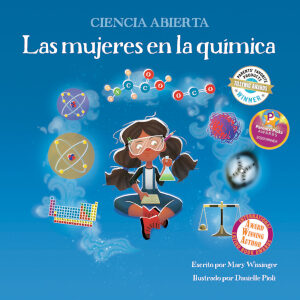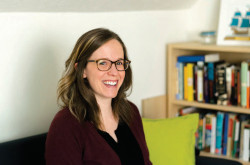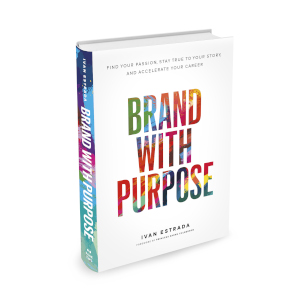Posted by Elena del Valle on August 10, 2022


Las mujeres en la química and Las mujeres en la física
Photos: Science, Naturally!
Targeting children aged seven to ten with English and Spanish language 37-page and 39-page titles about the sciences Science, Naturally! released Las Mujeres en la química and Las mujeres en la física by Mary Wissinger last year. Danielle Pioli illustrated the titles. The books are translations of Women in Chemistry and Women in Physics originally published by Genius Games LLC in 2016.

Women in Chemistry
Michelle A. Ramirez and The Spanish Group were responsible for translating both titles. Lidia Diaz, Ph.D., and Camilla Hallman are listed as Spanish-language consultants for Las mujeres en la física. Spanish-Milka O. Montes, Ph.D., and Hallman are listed as Spanish-language consultants for the second Spanish language book. All titles have a $12.95 cover price.

Dia L. Michels, publisher, Science, Naturally!
“We have promoted these books across all of our social media platforms and to our newsletter subscribers,” said Dia L. Michels, publisher, Science, Naturally! via email when asked in what ways and via what channels her company has promoted the titles. “We also reached out to educators, librarians, and STEM programs. And, of course, to the reviewers and customers who already love our other Spanish-language books! They are always excited to hear about new ways to share STEM content with children. We submitted Las mujeres en la química for Empowering Latino Future’s International Latino Book Awards, under the translation category, and it earned an award. We take pride in the amount of effort we put into each of our books to ensure that the translation captures both the content and the feeling of the English editions, so the fact that we can promote these titles by pointing to a translation award is a huge achievement! Empowering Latino Futures also does a bit of promotion for their award-winning authors to help make quality Spanish-language resources easier to find.”

Mary Wissinger, author, Women in Chemistry and Women in Physics
Wissinger was born and grew up in Wisconsin where she dove into storytelling through acting, singing, and writing. A former teacher, according to her biography she can be found at her standing desk in St. Louis, Missouri, “writing stories to inspire curiosity about the world and connection with others.” She is the author of the Science Wide Open Series and the My First Science Textbook Series.

Danielle Pioli, illustrator, Women in Chemistry and Women in Physics
Artist and illustrator Pioli, drawn to magic (what she calls quantum physics now), is on a mission to inspire others to create. According to her biography, “The idea of creating a whole universe from her mind to paper is what made her fall in love with art and storytelling.” She creates art, illustrations, comics, zines, poems, songs, and hypnotherapy sessions. She is the illustrator of the Science Wide Open Series.

Women in Physics
Three new books in the Science Wide Open series are due out in September 2022: Women in Engineering, Women in Medicine, and Women in Botany. Spanish versions titled Las mujeres en la ingeniería, Las mujeres en la medicina, and Las mujeres en la botánica are expected early next year, according to Michels.
Comments:
Filed Under: Books
Posted by Elena del Valle on May 18, 2022

52 Ways to Walk
Photo: Penguin Random House
British author Annabel Streets is a fan of walking under a wide variety of conditions. In her new book, 52 Ways to Walk: The Surprising Science of Walking for Wellness and Joy, One Week at a Time (G.P. Putnam’s Son, $24), she proposes a different walk for each week of the year. Each short and easy to read chapter outlines a type of walk such as in cold weather, at altitude, slow, in solitude, with a dog, with a map, on muddy ground, hungry, backward and others along with its benefits.
She includes the findings of researchers or scientific studies supporting the health benefits of such walking conditions. Each chapter begins with a historic reference and concludes with a list of tips. For example, in the chapter on walking with a dog she suggested readers might consider borrowing a dog from a friend or via a program.
The 267-page hardcover book is divided into 52 chapters. Streets did not respond to several emails sent to her website address. The publicity contact listed on the author’s website indicated she doesn’t represent the author. According to her biography Streets is a writer of “highly researched, fiction as well as both narrative and practical nonfiction;” and under the name Annabel Streets, which she uses for “practical nonfiction,” she is coauthor of The Age Well Project.
Comments:
Filed Under: Books
Posted by Elena del Valle on March 30, 2022

Brand With Purpose
Photos: book cover, Page Two Publications; author, Ian Maddox
With the help of sponsors and a GoFundMe campaign Los Angeles realtor Ivan Estrada dedicated some three years to the publication of Brand With Purpose Find Your Passion, Stay True to Your Story and Accelerate Your Career (Page Two, $25), a 277-page hardcover autobiographical branding book. According to the author the book is for anyone in business, not just real estate practitioners.
“Brand With Purpose is filled with tools and expert advice on growing your career and business, with enlightening case studies and inspirational wisdom from other successful trailblazers,” Estrada said by email via an intermediary. “In this book, Ivan recounts his journey of growing up Latinx, queer, and working class, and shares the critical lessons about personal growth and self-discovery he learned along the way.”

Ivan Estrada, author, Brand With Purpose
When asked to define the primary target audience for the book he said, “The primary audience for this book is younger entrepreneurs and teenagers. This book is something that I wish I had early in my entrepreneurial career. Of course, I wouldn’t change a thing; I love where I am today. However, if I can change the path of a young entrepreneur or teenager, that would be amazing for me. Brand With Purpose is also for those looking to get inspired and be motivated. If someone feels stuck or needs a change of pace, this book would be great for them as well.”
Regarding funding of the title he said, “Yes, we did receive sponsorship funds and in-kind support. The Sponsorship funds came from Making Education The Answer (META) Foundation, Leap foundation, Junior League of Los Angeles, University of Southern California Lambda Scholars, The Harmony Project, and Youth Business Alliance. We also organized a Go fund-me teaming up with Next Gen to donate books to students in Los Angeles. I was blessed to have family, friends, coworkers and colleagues make contributions for the book as well.”
How will he measure success? “Just being able to influence one person and change their path, allowing them to go down a more authentic and purposeful path, is more than enough. I don’t make judgments wholly based on sales numbers and the revenue generated. If I can help just one person change their life to be more meaningful, authentic, and purposeful, it helps fuel my purpose. Since the book was published, I have had people reach out to me via text, email, and social media, telling me that the book changed their life in some shape or form, and that was when I knew the book was a success, and I hope I continue to find success.”
Comments:
Filed Under: Books
Posted by Elena del Valle on February 23, 2022

Southbound
Photos: University of Georgia Press for cover, Mira Sydow for author photo
Anjali Enjeti, who teaches creative writing at Reinhardt University, believes her move from Michigan in 1984 to Tennessee forced her to experience a new environment where she was racially targeted. In Southbound Essays on Identity, Inheritance, and Social Change (University of Georgia Press,$24.95) she describes the effects of the move on her life, on her own self-perception and as the source of much anger.
When asked if there is a way to right wrongs without discriminating and or committing new wrongs she replied, by email via her publisher, “I suppose we’d have to define what we mean by discrimination. Is undoing some of the legacy of slavery or Jim Crow through affirmative action in college admissions discrimination? Is providing grants to minority owned businesses discrimination? Of course not. Attempts to level the playing field and address the ways that systems have historically marginalized various groups are not discrimination, and they are certainly not committing new wrongs.
What’s that saying? When you’re accustomed to privilege, equality feels like discrimination. We can’t right wrongs unless we go deep into history, understand systems of power, and how they benefit, and explore how meaningful reparations can make people whole again. For people who are privileged, I suppose this could look like committing new wrong, but it’s really not.”
“The problem is that the people who are deciding how to right wrongs are often very privileged folks who have never been harmed by these wrongs to begin with,” she said when asked to define the boundaries to address such changes and who gets to decide. “In an ideal world, the communities who have endured the harm will get to decide how we can address the harm. Communities most affected by police violence, for example, should determine whether their city’s police force should be defunded and what community programs should be implemented to replace the police.”
When asked who should shoulder the burdens, financial and otherwise, of righting those wrongs she said, “In some sense, we all should. We all pay taxes, and our taxes should absolutely be going toward righting wrongs. Our governments and agencies need to center those most harmed. But more generally speaking, people with privilege need to get more involved in writing the wrongs. We need to be supporting mutual aid organizations by amplifying their work and donating funds. We need to quit self-segregating and push for programs that help everyone.”
When asked if “articles must be judged for bias on an individual basis” as she states in her book how she would judge her book for bias she replied, “Because I wrote Southbound, it’s difficult for me to judge it for bias – that’s a job better left to readers! But I did hire an authenticity editor for the book. She went through the manuscript with a fine tooth comb to help ensure that my words didn’t harm others.
We are all biased as human beings – we can’t not be. And of course this bias is reflected in our writing. But we need to be cognizant of the fact that our internalized biases in writing can harm others, and minimize this harm as much as possible.”
In relation to the anger she described feeling in her book and the acceptable limits of anger she said, “Well if we’re talking strictly about anger, not, say, harassment, bullying or other kinds of violence, then I don’t believe there are or should be acceptable limits to anger. But I suppose this is because I don’t see anger as a failing or an inherently bad thing to begin with – I find it crucial to justice work and the push to make our world more humane. Ultimately, anger is the engine for advocacy.
At this very moment, scientists, and doctors from all over the world are railing against governments and public health bodies that have failed to do their due diligence to slow the spread of COVID and take care of our most vulnerable people. Their critiques have been harsh, angry, enraged. We’re talking about the value of human life. So I don’t find this anger unacceptable in any way – it’s being deployed to reduce and end suffering.
And on an individual level, anger is such an important emotional release. I’m angry when my children are mistreated by others. I’m angry about my chronic pain. I’m angry about a lot of things. This kind of anger is healthy and important and helps me cope. It also helps me grow. And after it’s released, I have far more space in my heart and head for joy.”

Anjali Enjeti, author, Southbound
When asked what prompted her to write the book she said, “I’ve been doing progressive social change work for most of my adult life. Even pre-2016, I never had any delusions about how this country worked, who it benefited, and who it disenfranchised, incarcerated, killed, or deported. But Trump’s election in 2016 shook me to my core. And then I learned something that shocked me – that Asian American and Pacific Islanders have one of the lowest voter turnouts among any racial group. So I switched into electoral organizing, and began volunteering for campaigns. It was different kind of work for me, and I was doing this work in my forties, a decade when my perspective on the world began gradually shifting. A space in my mind began to open up for this book to come through.”
From idea to publication it took five years for the 230-page softcover book to be published in 2021. About 20 percent of the essays in the collection had previously been published.
She added, “And my ideas for new essays were seeds that had been planted in my mind years earlier, so by the time I sold the book proposal to UGA Press and sat down to write them, the essays came easily to me.”
Regarding the primary target audience for the book she said, “I wrote this book for all kinds of people, including southerners, and people of multi-ethnic or multi-racial identity. But I primarily wrote this book for people who think about social change, and activism, and for those whose identities and communities shape how they hope to get involved in social change work. I wanted to write about what identity can do out in the world, how it can build coalitions within and between communities, and this is the audience I was hoping would find the book.”
When asked for her definition of ethnicity she said, “Ethnicity is a cultural group irrespective of race.” To the idea that some people dislike or take offense to labels that others consider essential to their identity and when it may be acceptable to describe someone as brown, black, white, white passing, she said, “This is an excellent question and it’s also a tough one to answer. Terminology to describe race or ethnicity is ever-evolving. It changes every few years, and with each generation. But I think the most important thing to understand is that communities are not monoliths. One person in a community might take offence to an identifier another member in that same community connects with.
I personally identify as mixed race and brown, but not all South Asians or Indians identify as “brown.” I also identify as a minority – a term that many non-white people reject, and I completely understand why. But I feel empowered by it. “Minority” has historically been used to define members of an ethnic or racial group that is smaller in number, but now minorities are becoming the majority, and I love the irony of using the term today where whites are now becoming the minority.
We need to be flexible when we discuss language of identity. It is not one-size-fits-all. We need to listen to individuals and respect how they want to be addressed.”
Comments:
Filed Under: Books
Posted by Elena del Valle on February 16, 2022

Sunbelt Blues
Photo: Andrew Ross for book cover photo, Valerie terranova for author photo
Andrew Ross, professor of social and cultural analysis at New York University (NYU), believes that housing is a human right. To explore housing issues in Osceola County he spent time in central Florida, between 2016 and 2020, meeting with public and private sector representatives, homeless advocates and homeless people living in motels and wooded land encampments. In Sunbelt Blues The Failure of American Housing (Metropolitan Books/Holt, $27.99), a 268-page hardcover book published in 2021, he shared his findings and thoughts about the housing issues in Osceola County and by extension other cities and states he believes present similar profiles and face comparable poverty and housing challenges.
From idea to publication the book he wrote for the general public required five years. When asked other than his salary as a professor at NYU what funding or support, if any, he received toward the book project and from whom he said by email “Research funding from NYU.”
Just how many homeless are there in Florida? That isn’t clear. One wooded area he visited in Osceola County, he says in the book, is home to as many as 15 camps of squatters many suffering from addiction. He pointed to a 2019 study that estimated 44 percent of homeless people in Florida (and 72 percent in California) were un-sheltered.

Andrew Ross, author, Sunbelt Blues
In the book he draws attention to the many people who become unhoused in central Florida after moving there in search of frost free living and jobs and find downward mobility instead. He points to the rise of a “rentership society” across the country. Private investors, whose identities are often hidden, have driven up the price of land, homes and rental rates while at the same time the money leaves the area, making tourist sites such as those in central Florida parasites on the surrounding region, he said in the book. In Sunbelt Blues he called for salary increases and rent control as well as nonprofit and public housing investments to counter the housing crisis in the state.
Just north of Osceola, in world famous Orlando, two thirds of residents are renters, according to his book. The majority of jobs in the region pay under $30,000 a year, he said in the book. At the same time Florida’s largest landowners, the Mormon Church, likely will decide the fate of North Ranch, a possible new city yet to be built for as many as half a million wealthy residents, according to his book.
The author said he will measure the success of the book depending on “Whether the book contributes to policy changes, or to changes in public consciousness (less difficult to gauge).” When asked what responsibility homeless people should have for their lack of housing he replied, “I would turn that question around and ask what responsibilities do employers, elected officials, and the real estate industry have for the lack of affordable housing.”
Given the repeated failures of governments dealing with homelessness what are the chances that local, state or national authorities will fix the problem in the next decade? His reply: “The scale of the housing crisis is so immense that comprehensive solutions are needed. The federal government is gridlocked, but can still do plenty in the way of expanding and upgrading its existing programs, while introducing new programs in public housing and social housing. Many local authorities are hamstrung by preemptive laws passed by state legislatures. These need to be repealed badly to allow counties and municipalities the flexibility they need to respond adequately,”
When asked if the owners of private land where the wood encampments are located are shouldering the burdens of the housing emergency in Osceola County he replied, “Not really. The encampments are generally on land that is not being used. When owners decide to develop the land, the camp dwellers get moved along to other locations.”
Comments:
Filed Under: Books
Posted by Elena del Valle on January 12, 2022

San Fransicko
Photo: Harper
California has serious problems that have resulted in many residents departing the state in search of a better life. So much so that there is a cottage industry of businesses assisting residents to relocate. San Francisco and Los Angeles in particular, have an epidemic of homelessness and untreated addiction as well as a mental health crisis, according to Michael Shellenberger. In San Fransicko Why Progressives Ruin Cities (Harper, $28.99), a 395-page hardcover book published in 2021, he discusses his thoughts on the situation in the city and its environs.
In the book he outlines the notable rise of homelessness, runaway addiction, open use of illegal drugs in public places, rampant crime and mental illness; all of which he thinks have made the area and its streets unsafe and driven tens of thousands of people away from the state and especially from the general San Francisco area. He quotes policymakers, critics, advocates of change, former San Francisco homeless and former addicts.
Hoards of homeless people, often attracted to the city’s progressive policies and economic incentives for the homeless, have made their way to San Francisco and the surrounding areas resulting in frequently unpunished crime by over lenient prosecutors, public use of illicit drugs in parks and streets as well as widespread public urination and defecation in some neighborhoods, he says in the book. He illustrates the situation by explaining that between 2015 and 2018 the city replaced 300 lampposts corroded by urine (after one of the corroded lampposts crushed a car).
San Francisco doles out significant amounts of cash to the poor when compared with other cities; $709 per capita compared to $195, $120 and $.34 in New York City, Chicago and Phoenix, he says. The city’s permissive drug use programs and policies and its refusal to prosecute crimes has resulted in steep increases in the use of heroin, meth and fentanyl and brazen and booming crime. Those issues have made the city expensive, unsafe, and unattractive to many businesses and residents. Between 2008 and 2019, he says, 18,000 businesses such as Hewlett-Packard, Toyota and Charles Scwab, fled the state.
Addressing the underlying issues that have made drug use, homelessness and crime thrive along with fostering policies that improve the availability of housing may pave the way to a possible future solution, he says. Part of the solution outlined in the book would require Californians to agree to more suburbs and development in ranches and farmlands, while leaving the city itself with limited further housing.
He believes the crisis of disorder thriving in San Francisco, Los Angeles and Seattle is spreading east. He describes a neoliberal model of government contracting to nonprofit service providers that are unaccountable as well as unable to address the crisis is underlying “the breakdown of civilization on America’s West Coast.”
Shellenberger is founder and president of Environmental Progress. He authored Apocalypse Never.
Comments:
Filed Under: Books
Posted by Elena del Valle on December 8, 2021

The Global Advertising Lawyers Alliance’s second edition of Sweepstakes & Contests
Photos: Global Advertising Lawyers Alliance, Frankfurt Kurnit Klein & Selz, Venable LLP, Davis+Gilbert LLP
The Global Advertising Lawyers Alliance (GALA) released a second edition of Sweepstakes & Contests: A Global Legal Perspective (Global Advertising Lawyers Alliance, $99), a 535-page softcover book offering “a detailed overview of the laws governing sweepstakes and contests in more than 70 countries around the world.” The primary target audience for the book? Mainly in-house counsel as well as others working in the area of developing promotions and sweepstakes for their companies, according to a GALA spokesperson. Copies of the digital edition (PDF) are available, as of this writing, free of charge via GALA. Print copies are available via Amazon.

Jeffrey A. Greenbaum, partner, Frankfurt Kurnit Klein & Selz
Three authors were responsible for the seven pages of the United States section: Melissa Steinman, partner, Venable LLP; Joseph Lewczak, partner, Davis+Gilbert LLP; and Jeffrey A. Greenbaum, partner, Frankfurt Kurnit Klein & Selz. In addition to updating existing chapters on legal developments since the first edition was published the new edition has 17 additional countries.
The book is organized in alphabetical order by country. Each chapter summarizes how sweepstakes and contests are regulated in that country. It includes rules, filing requirements, prizes, tax liabilities, and important cases for each country.

Melissa Steinman, partner, Venable LLP
According to Steinman, who responded to questions via email with the help of a GALA intermediary, the most salient issues relating to sweepstakes and contests in the United States in the recent years are, “In the US, like in many/most countries, the biggest issue in sweepstakes and contests in the past couple of years was COVID. The circumstances of the pandemic forced promotion sponsors to face situations where a given travel prize might not be available or a promotion might need to be postponed or cancelled altogether? was legal raised interesting questions about consideration and healthcare privacy. Additionally, ‘Vax Sweepstakes’ became popular as many companies—and even some states—offered vaccine incentive programs in the form of sweepstakes to encourage vaccination. For example, United Airlines’ ‘Your Shot to Fly’ sweepstakes asked entrants to upload proof of vaccination to their United account for a chance to win to win airline tickets, and the state of Ohio offered one million dollars as a prize in its ‘Vax-a-Million Sweepstakes.’ These programs raise unique questions, such as (a) whether requiring a vaccine to participate is consideration; (b) whether the sponsor must allow for exemptions for medical and/or religious reasons; (c) health care privacy issues; and (d) (for employee promotions), potential labor/union issues. The FTC [Federal Trade Commission] also brought deceptive practices actions related to COVID, including promotions: in FTC v. Traffic Jam Events, 2:20-cv-1740 (2020), the FTC took action to halt a scheme by auto dealers that allegedly deceived consumers with ‘prize’ mailers supposedly directing them how to obtain federal COVID-19 stimulus benefits, which instead lured them to a used car sale.
We are also starting to see sweepstakes and contests involving cryptocurrency and NFTs [non fungible tokens]. A class action has been filed against a cryptocurrency exchange platform, Coinbase, over allegedly misleading sweepstakes advertising relating to Coinbase’s Dogecoin Sweepstakes. The complaint alleged that the sweepstakes was advertised in a deceptive and misleading way because the free method of entry was not clearly disclosed in email and website advertising, so entrants believed the only way to enter was by signing up for a Coinbase account and buying or selling $100 in Dogecoin. This is a familiar claim, but a new platform.”

Joseph Lewczak, partner, Davis+Gilbert LLP
According to Steinman, the most notable developments relating to sweepstakes and contests at a global level are “This past summer, Quebec, Canada changed its rule requiring registration of most game promotions. Prior to that, the Régie des alcools des courses et des jeux (Régie) in Quebec, Canada had strict registration and fee requirements that led many promotion sponsors deemed extremely cumbersome to exclude residents of Quebec from promotions. Now, so long as sweepstakes and contests are also open to entrants from outside of Canada and there is no Canada-only prize pool, such promotions are not subject to the Régie’s registration requirements. Note that like all advertising and promotion materials, including rules, must be translated into French for Quebec residents.” And “Additionally, in 2019, Sweden’s new Gambling Act went into force. This law liberalized the rules on lotteries to the point where for the first time, promoters can offer promotional games of chance with no purchase required in Sweden—they were previously prohibited.”
The main difference between the first and second United States editions Steinman explained is that “We have added 17 new countries: Bosnia & Herzegovina, Cyprus, Egypt, El Salvador, Estonia, Ghana, Guatemala, Honduras, Kenya, Latvia, Lithuania, Nigeria, Romania, Serbia, Trinidad & Tobago, the United Arab Emirates, and Zimbabwe. We have added two new questions: Are raffles or charitable sweepstakes regulated differently than prize promotions offered by for-profit corporations? Are there any special rules for chance-based games, skill-based contests or other giveaways based on the audience that may enter (e.g., sweepstakes for children, employee contests, ladies’ night promotions, scholarships offered only to a minority group)?”
According to a recent press release, GALA is an alliance of lawyers located throughout the world with expertise and experience in advertising law. It has members representing more than 95 countries. GALA offers guides to advertising in a number of countries, including Advertising Law: A Global Legal Perspective, Ambush Marketing: A Global Legal Perspective, Privacy Law: A Global Legal Perspective on Data Protection Relating to Advertising and Marketing, and Social Media: A Global Legal Perspective. The organization is planning a webinar, Global Sweepstakes & Contests, moderated by Steinman to highlight key updates in the book, on January 27, 2022.
Comments:
Filed Under: Books
Posted by Elena del Valle on October 13, 2021

The Aristocracy of Talent
Cover: Skyhorse/Simon & Schuster
New talent was one of the secrets of success for ancient Venice, Italy and great universities. That is one of the conclusions drawn by Adrian Wooldridge after dedicating 482 pages to the exploration of the history of meritocracy in his most recent non fiction book titled The Aristocracy of Talent How Meritocracy Made the Modern World (Skyhorse/Simon & Schuster, $24.99). The hardcover book was published in July 2021.
Venice thrived as long as it was open to new arrivals, the author says in the book. Once it became a closed society, denying opportunities to new voices and talent it decayed and never recovered, he says. A similar situation is to be found at higher centers of learning, he points out, where elites rule and exclude most newcomers; as a result economies are stagnating and political unrest is growing internationally. He concludes that in order to avoid the decline suffered by Venice and Chinese domination Western society must embrace merit as a key to education, economic and social advancement.
Wooldridge, who according to his biography, earned a doctorate in history from Oxford University is the political editor and a columnist at The Economist. He is the author of 10 previous books.
Comments:
Filed Under: Books
Posted by Elena del Valle on September 29, 2021

Delicious
Photos: Princeton University Press
Do humans and other animals prefer to eat foods that taste good when they have a choice? Rob Dunn, a professor of applied ecology at North Carolina State University, and Monica Sanchez, a medical anthropologist, think so. In Delicious The Evolution of Flavor and How It Made Us Human (Princeton University Press, $27.95) they explore the history of man, our ancestors and fellow primates and its relationship to flavor.
The authors, speaking in a single voice in the book, believe taste receptors have driven animals and humans toward their needs and kept them away from dangers such as poisonous plants and rotten foods. Flavor preferences may have driven the development of tools and the choice of foods that prompted evolutionary changes, they propose. Aromas sensed in the mouth by primates and humans may have been especially important in the evolution of our kind, they believe.

Rob Dunn and Monica Sanchez, authors, Delicious
Some of those flavor preferences may have driven humans and neanderthals to hunt mega fauna to extinction. They also discuss the consumption of fruit, spices, meats and grains by our ancestors and their possible reliance on their noses and mouths in their choices and creation of spiced dishes and fermented foods. They delve into issues such as aroma, taste and mouthfeel and how they might have led to the development of popular foods such as curry, stinky tofus and cheeses.
In their book Dunn and Sanchez often refer to and quote the work of French lawyer Jean Anthelme Brillat-Savarin, famous for his love of food, dating back to 1825. The 279-page hardcover book published this year is divided into nine chapters: Tongue-Tied, The Flavor Seekers, A Nose For Flavor, Culinary Extinction, Forbidden Fruits, On the Origin of the Spices, Cheese Horse and Sour Beer, The Art of Cheese, and Dinner Makes Us Human.
According to their book biographies Dunn is in the Center for Evolutionary Hologenomics at the University of Copenhagen. Sanchez studies “the cultural aspects of health and well-being.” They live in North Carolina.
Comments:
Filed Under: Books
Posted by Elena del Valle on August 4, 2021

Crypto Wars
Photos: Kogan Page, Erica Stanford
Fraudsters and scammers are conning millions of people out of their life savings every year using cryptocurrency scams, according to Erica Stanford. She says an underworld of dirty dealing and scams has opened around cryptocurrencies. Those behind the frauds are relying on a variety of strategies such as cult-like tactics, celebrity endorsements and events filling Wembley Arena in London, United Kingdom; it’s shockingly easy to be deceived she says in Crypto Wars Faked Deaths, Missing Billions and Industry Disruption (Kogan Page, £14.99). The softcover book was published July 1, 2021.
It took Stanford a year to research, write and edit the book. In it she shares the stories behind the biggest scams on record, including a death faking Canadian founder who escaped with millions, a so called Cryptoqueen on the run from the Federal Bureau of Investigation and a $50 million dollar prank gone wrong. When asked if she received compensation to include or exclude anyone she clarified, via a publicist, that she “did not receive any form of compensation to leave anyone out of the book.”
When asked what is the primary target audience for the book she replied: “Anyone! It’s intended to be fun, light reading, giving an easy-to-read overview of the worst scams and craziest stories of the crypto space.”

Erica Standford, author, Crypto Wars
“It was the publishers’ idea!,” she replied when asked why she wrote the book and how she will know if she was successful. “They approached me with the idea to write about the biggest scams in crypto. Successful – gosh, just finishing it, I was happy! I’d never done anything like that before and still can’t quite believe I’ve actually written a book, that it’s published and so many people are buying it! When I saw it in a shop for the first time, WH Smiths in London had made it as their business book of the month. I couldn’t quite believe it when I saw it really prominently displayed on shelves in a shop.”
Regarding the means and specific channels in which she promoted the book she replied, “The publishers have been a great help in this and have got the book listed with retailers and Amazon, as well as organising some PR. I have shared the book widely on LinkedIn and with all my connections in our Crypto Curry Club community, who have been very supportive and helped share it with their networks and in our Crypto Curry newsletter. I also reached out to some podcast hosts, as well as being asked to be on many podcasts and interviews with show hosts who wanted to talk about crypto scams. Most of the time trying to promote the book has been guest appearances on podcasts and writing articles for publications and newspapers who have been keen to feature it.”
When asked what, if any, impact the pandemic continuing may have on cryptocurrencies she replied, “It has raised awareness! More people than ever before, especially younger people, are looking at crypto, aware of some of the failures of fiat, of money printing and inflation and losing trust in governments, and it seems people have also just had more time to look into it.”
“Do an awful lot of research before looking at going anywhere near crypto!” she said when asked what she would advise readers seeking to understand blockchain and cryptocurrencies and considering investing in them. “Andreas Antonopoulos has an incredible book giving insights on Bitcoin called The Internet of Money, it’s a great read.”
According to her biography Stanford is a crypto entrepreneur and expert, who founded the United Kingdom’s biggest crypto network, and a lecturer at Warwick Business School in the United Kingdom. Kogan Page is an independent publisher of business books and content, according to a press release.
Comments:
Filed Under: Books

































